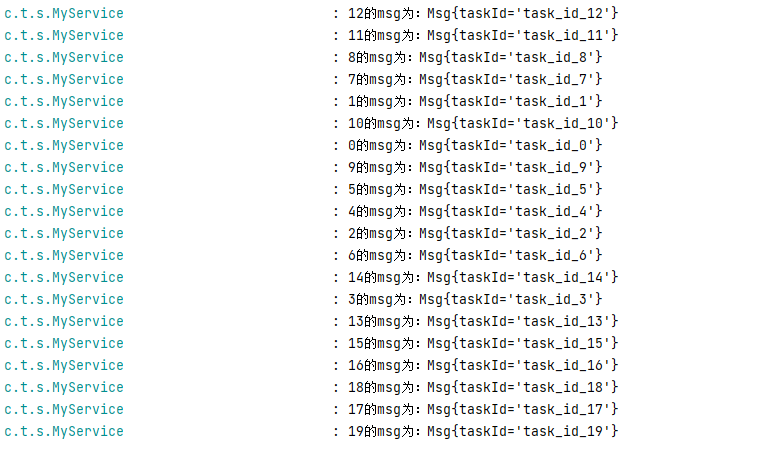在日常研发过程中,我们经常面临着需要在线程内,线程间进行消息传递,比如在修改一些开源组件源码的过程中,需要将外部参数透传到内部,如果进行方法参数重载,则涉及到的改动量过大,这样,我们可以依赖ThreadLocal 来进行消息传递。
ThreadLocal 是 存储在线程栈帧中的一块数据存储区域,其可以做到线程与线程之间的读写隔离。
但是在我们的日常场景中,经常会出现 父线程 需要向子线程中传递消息,而 ThreadLocal 仅能在当前线程上进行数据缓存,因此 我们需要使用 InheritableThreadLocal 来实现 父子线程间的消息传递
// 定义消息
public class ThreadLocalMessage { private final InheritableThreadLocal<Msg> msg; private ThreadLocalMessage() { msg = new InheritableThreadLocal<>(); } public Msg getMsg() { return this.msg.get(); } public void setMsg(Msg msg) { this.msg.set(msg); } public void clear() { msg.remove(); } private static final ThreadLocalMessage threadLocalMessage = new ThreadLocalMessage(); public static ThreadLocalMessage getInstance() { return threadLocalMessage; } /** * 获取线程中的消息 * * @return */ public static Msg getOrCreateMsg() { Msg msg = ThreadLocalMessage.getInstance().getMsg(); if (msg == null) { msg = new Msg(); } return msg; } public static class Msg { /** * taskId */ private String taskId; private Map<String, Object> others; private int retCode; public Msg() { } public String getTaskId() { return taskId; } public void setTaskId(String taskId) { this.taskId = taskId; } @Override public String toString() { return "Msg{" + "taskId='" + taskId + '\'' + ", others=" + others + ", retCode=" + retCode + '}'; } } }
// 定义线程池
@EnableAsync @Configuration public class ExecutorConfig { private final Logger log = LoggerFactory.getLogger(getClass()); @Value("${executor.corePool:2}") private Integer corePool; @Value("${executor.maxPool:10}") private Integer maxPool; @Value("${executor.queue:2}") private Integer queue; @Bean("cdl-executor") public Executor executor() { log.info("start async Executor"); ThreadPoolTaskExecutor executor = new ThreadPoolTaskExecutor(); //配置核心线程数 executor.setCorePoolSize(corePool); //配置最大线程数 executor.setMaxPoolSize(maxPool); //配置队列大小 executor.setQueueCapacity(queue); //配置线程池中的线程的名称前缀 executor.setThreadNamePrefix("async-executor-"); // 设置拒绝策略 executor.setRejectedExecutionHandler((r, e) -> { // ..... }); // CALLER_RUNS:不在新线程中执行任务,而是有调用者所在的线程来执行 executor.setRejectedExecutionHandler(new ThreadPoolExecutor.CallerRunsPolicy()); //执行初始化 executor.initialize(); return executor;
// 使用TTL 初始化 executor //return TtlExecutors.getTtlExecutor(executor); } }
// 创建子线程进行消息传递并打印
public String test() throws Exception{ for (int i = 0 ; i < 20; i++){ ThreadLocalMessage.Msg msg = ThreadLocalMessage.getOrCreateMsg(); msg.setTaskId("task_id_"+i); ThreadLocalMessage.getInstance().setMsg(msg); myService.testThread(i); ThreadLocalMessage.getInstance().clear(); } return "ok"; }
经过代码测试,我们创建了一个池子大小为10 的线程,并发启动了20个线程去进行父子线程消息传递,结果如下:

经过测试,我们发现 只有10个线程 的消息传递成功了,其余10个线程的消息均丢失了,这是什么原因呢。。。
遇到这个问题,我们首先得弄清楚 InheritableThreadLocal 是如何在父子线程间进行消息传递的
InheritableThreadLocal 在父线程创建子线程的时候,会将父线程中InheritableThreadLocal 中存储的数据 拷贝一份 存储到子线程的 InheritableThreadLocal 中
而我们使用的 线程池,线程池是会反复利用线程的,当线程池没有被创建满,每次都是新创建线程,直到线程池创建满了,再需要使用线程就会从线程池中拿已经创建好的线程。
问题就出在这里,由于后面的线程 是从线程池中去捞已经创建好的线程,不会走创建逻辑,也就无法触发 InheritableThreadLocal 中向子线程 拷贝,这也就是为什么 InheritableThreadLocal 合并线程池 使用时,出现了 消息丢失的原因
如何解决????
阿里巴巴开源的TTL ,用于解决线程池中的父子线程复用,线程数据传递,可以完美解决这个问题
<dependency>
<groupId>com.alibaba</groupId>
<artifactId>transmittable-thread-local</artifactId>
<version>2.0.0</version>
</dependency>
@EnableAsync
@Configuration
public class ExecutorConfig {
private final Logger log = LoggerFactory.getLogger(getClass());
@Value("${executor.corePool:2}")
private Integer corePool;
@Value("${executor.maxPool:10}")
private Integer maxPool;
@Value("${executor.queue:2}")
private Integer queue;
@Bean("cdl-executor")
public Executor executor() {
log.info("start async Executor");
ThreadPoolTaskExecutor executor = new ThreadPoolTaskExecutor();
//配置核心线程数
executor.setCorePoolSize(corePool);
//配置最大线程数
executor.setMaxPoolSize(maxPool);
//配置队列大小
executor.setQueueCapacity(queue);
//配置线程池中的线程的名称前缀
executor.setThreadNamePrefix("async-executor-");
// 设置拒绝策略
executor.setRejectedExecutionHandler((r, e) -> {
// .....
});
// CALLER_RUNS:不在新线程中执行任务,而是有调用者所在的线程来执行
executor.setRejectedExecutionHandler(new ThreadPoolExecutor.CallerRunsPolicy());
//执行初始化
executor.initialize();
// 使用TTL 的 executor
return TtlExecutors.getTtlExecutor(executor);
//return executor;
}
}
public class ThreadLocalMessage {
private final TransmittableThreadLocal<Msg> msg;
private ThreadLocalMessage() {
msg = new TransmittableThreadLocal<>();
}
public Msg getMsg() {
return this.msg.get();
}
public void setMsg(Msg msg) {
this.msg.set(msg);
}
public void clear() {
msg.remove();
}
private static final ThreadLocalMessage threadLocalMessage = new ThreadLocalMessage();
public static ThreadLocalMessage getInstance() {
return threadLocalMessage;
}
/**
* 获取线程中的消息
*
* @return
*/
public static Msg getOrCreateMsg() {
Msg msg = ThreadLocalMessage.getInstance().getMsg();
if (msg == null) {
msg = new Msg();
}
return msg;
}
public static class Msg {
/**
* taskId
*/
private String taskId;
public Msg() {
}
public String getTaskId() {
return taskId;
}
public void setTaskId(String taskId) {
this.taskId = taskId;
}
@Override
public String toString() {
return "Msg{" +
"taskId='" + taskId + '\'' +
'}';
}
}
}
按照之前的调用方法再试一次,结果如下:

可以发现未出现数据丢失的情况
【文章原创作者:武汉网站建设 http://www.wh5w.com欢迎留下您的宝贵建议】
